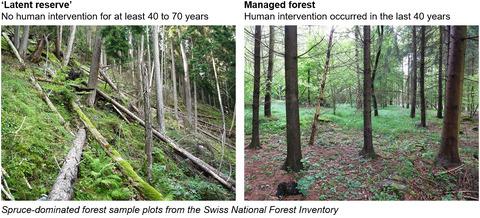Our official English website, www.x-mol.net, welcomes your
feedback! (Note: you will need to create a separate account there.)
‘Latent reserves’: A hidden treasure in National Forest Inventories
Journal of Ecology ( IF 5.3 ) Pub Date : 2020-08-11 , DOI: 10.1111/1365-2745.13487 Jeanne Portier 1 , Jan Wunder 1, 2 , Golo Stadelmann 1 , Jürgen Zell 1 , Meinrad Abegg 1 , Esther Thürig 1 , Brigitte Rohner 1
中文翻译:

“潜在储备”:国家森林清单中的隐藏宝藏
更新日期:2020-08-11
Journal of Ecology ( IF 5.3 ) Pub Date : 2020-08-11 , DOI: 10.1111/1365-2745.13487 Jeanne Portier 1 , Jan Wunder 1, 2 , Golo Stadelmann 1 , Jürgen Zell 1 , Meinrad Abegg 1 , Esther Thürig 1 , Brigitte Rohner 1
Affiliation

|
- In a Europe shaped by centuries of forest management, the task of today's scientists in characterising, understanding and modelling natural forests is highly challenging. Although numerous forest reserves exist, most remain hardly comparable case studies. Contrarily, National Forest Inventories (NFIs) consist of systematically distributed sample plots with varying time since last intervention and provide representative data. These characteristics make NFIs a unique opportunity to investigate hidden natural forests.
- Here we propose using NFI plots free of human influence for >40 to >70 years (‘latent reserves’) to conduct large‐scale studies on near‐natural forests. We tested this original concept in Swiss forests. We characterised compositional and structural attributes of ‘latent reserves’ and compared them with those of managed forests to assess whether the former demonstrated more signs of naturalness than the latter. As an example of an application, we analysed the tree‐ and stand‐level factors affecting natural tree mortality in ‘latent reserves’.
- Up to 15.3% of Swiss NFI plots fulfilled the criteria of ‘latent reserves’, and most of these plots were distributed at mid‐ to high elevations where accessibility and management opportunities are limited. ‘Latent reserves’ showed more signs of naturalness than managed forests—a higher proportion of broadleaves, higher mortality rates, higher stand density and more deadwood. However, their size structure and basal area did not differ from those of managed forests, most likely because of a lower site productivity. Although ‘latent reserves’ were transitioning towards a natural state, more time without management might be required for these forests to become fully detached from the effects of past management, especially at high elevations. Mortality analyses in ‘latent reserves’ showed that species‐specific tree mortality had a U‐shaped response to tree size, was negatively related to tree growth and was higher when competition was stronger.
- Synthesis. Our findings demonstrate the potential of ‘latent reserves’ to study near‐natural forests at the country level, and point to further opportunities for larger‐scale collaborations. Investigating ‘latent reserves’ represents a first step towards a deeper understanding of such forests using existing long‐term data and shows promise for further research in Europe.
中文翻译:

“潜在储备”:国家森林清单中的隐藏宝藏
- 在一个由几个世纪的森林经营形成的欧洲中,当今的科学家在表征,理解和建模天然森林方面的任务非常具有挑战性。尽管存在大量的森林保护区,但大多数案例仍然很难进行比较。相反,国家森林清单(NFI)包括系统分布的样本区,自上次干预以来时间有所不同,并提供代表性数据。这些特征使NFIs成为了调查隐藏的天然森林的独特机会。
- 在这里,我们建议使用在40到70多年没有人为影响的NFI地块(“潜在储量”)对近天然森林进行大规模研究。我们在瑞士森林中测试了这个原始概念。我们表征了“潜在保护区”的组成和结构属性,并将其与人工林的属性进行比较,以评估前者是否比后者拥有更多的自然迹象。作为一个应用示例,我们分析了影响“潜在储备”中自然树死亡率的树木和林分因素。
- 高达15.3%的瑞士NFI地块符合“潜在储量”的标准,并且这些地块中的大多数分布在中高海拔地区,可访问性和管理机会有限。“潜在储量”显示出比经管理的森林更多的自然迹象-阔叶树比例更高,死亡率更高,林分密度更高和枯木更多。但是,它们的大小结构和基础面积与人工林没有什么不同,这很可能是因为场地生产力较低。尽管“潜在保护区”正在向自然状态过渡,但要使这些森林完全脱离过去的管理影响,尤其是在高海拔地区,可能需要更多的时间来进行管理。
- 综合。我们的发现证明了“潜在保护区”在国家一级研究近乎天然森林的潜力,并指出了开展更大规模合作的更多机会。调查“潜在储量”代表了使用现有的长期数据来加深对此类森林的了解的第一步,并显示了在欧洲进行进一步研究的希望。











































 京公网安备 11010802027423号
京公网安备 11010802027423号